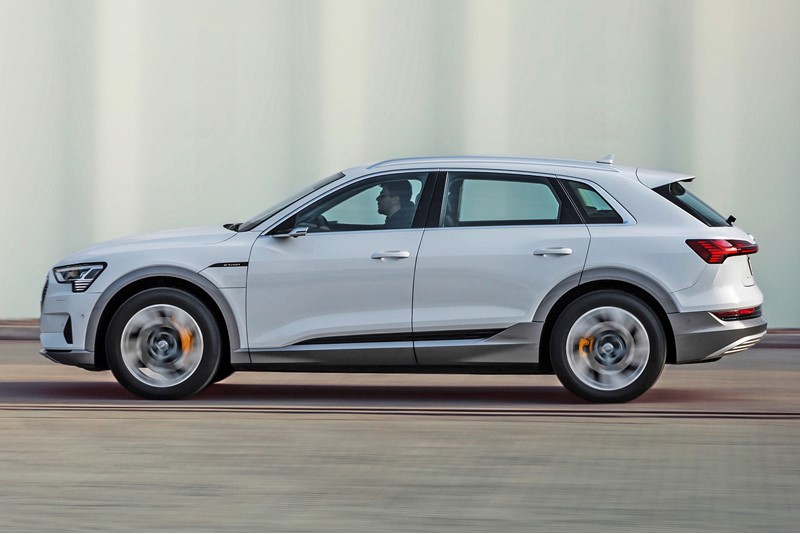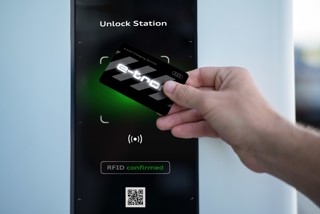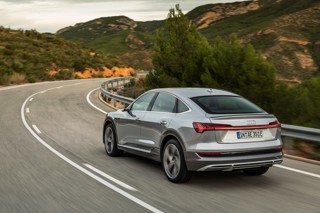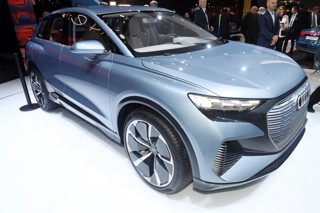Zero per cent benefit-in-kind (BIK) tax, corporate social responsibilities and new attitudes towards driving shaped during lockdown are accelerating demand for electric vehicles (EVs).
Leasing companies report more orders taken in the first quarter of 2020 than during the whole of 2019. The switch has been flipped.
Audi is cresting the wave of corporate interest with a product launch plan that will result in a line-up of five plug-in hybrids and four full electric vehicles by the end of the year.
From a near standing start a little more than six months ago, electric product is already accounting for around a quarter of orders and “could rise to 40% and even further as we go into next year”, according to head of fleet James Buxton.
“It’s accelerating quickly as we had the customer conversations over the past nine-to-12 months on the e-tron (pictured below),” he adds. “It was relatively niche; now that car is dominant on the meeting agendas. I can see parity between our alternative fuel vehicles and ICE (internal combustion engine) order bank happening pretty quickly.”
The lockdown caused by the coronavirus pandemic has stymied demand, but not erased it completely. Pent-up demand is high, and even during the depths of lockdown Audi took more than 1,000 fleet orders.
The carmaker took the decision to delete many of the stock orders it had in the system to ensure that any customer order would take priority. As a result, Buxton does not anticipate any extended delivery times due to global production pauses during Covid-19.
“The number of customers still operating has been quite significant,” he says. “Our primary focus has been ensuring our customers and dealers know what’s going on regarding our product, logistics and shipping and that we know what’s going on from their perspective – we have to work in partnership.”
Widespread uncertainty
He recognises and accepts the widespread uncertainty among companies which may still have staff on furlough and are not yet sure of when they will return to work. Audi has told them it will hold cars that have been ordered if necessary, as it strives to “be flexible where we can to deliver a solution that works for the customer”.
Audi’s expectations for the balance of 2020 are in line with general market sentiment: that the final six months will see demand return close to original forecast levels. True fleet registrations in the first half of the year fell by 48% on 2019 and some of that business is lost across all manufacturers. “How much is the big question,” Buxton notes.
Demand has fluctuated by industry sector – healthcare stayed high, hospitality was low, for example – but, while corporate interest evaporated during April and May, it started to return in June with electric product topping the list of enquiries.
“This was the trend pre-lockdown and, if anything, that has accelerated post-lockdown,” says Buxton.
“How that market develops over the next 12-18 months will be interesting. Does lockdown have a direct impact due to (people) working from home and less mileage? It could be a tipping point.”
Buxton remains “excited” about the rest of the year with the new PHEV (plug-in hybrid engined vehicles) and BEV (battery electric vehicle) models which are being priced with fleet in mind.
“We have the e-tron and the e-tron 50 which we introduced with a lower entry price with a view on fleet. The order take is superb and the order bank for the rest of the year is fantastic,” he says.
“We’ve seen some customers allowing their employees to upgrade to the e-tron, which they wouldn’t allow for ICE. It’s because of their commitment to reducing CO2.”
He adds: “This is an area where we can work with customers to make these vehicles more accessible. The acquisition price can be higher, but we are trying to equalise that position, and this will happen over time.”

While the e-tron is an important milestone, all Audi eyes are really fixed on the plug-in A6 saloon, “a big car for us”. Quoting has started, with early feedback from leasing companies suggesting the car is well positioned in the segment.
With BIK of just 10%, 34 miles of electric-only range, 35g/km of CO2, 188mpg and a charging time of 2.5 hours, it’s little surprise Buxton predicts it could account for “at least 70%” of corporate registrations – potentially around 4,500 units, based on the A6’s sales performance last year.
Other PHEVs now available to order include the A8 TFSIe (recently tested in Fleet News), Q5 e-tron (expected to account for more than 30% of Q5 sales) and Q7 TFSIe, with the A3 “in the pipeline”.
Then, towards the end of 2020, possibly falling into 2021, comes the Q4 e-tron full electric compact SUV.
Electric product provides Audi with a short-term opportunity over the next 12-18 months to exploit its inherent brand appeal with drivers, particularly those who have opted out of the company scheme but could be enticed back thanks to the preferential BIK position.
“Brands with strong desire and product range will benefit from people returning to the company car scheme,” Buxton says. “It’s also great for employers because they will have greater insight of the cars their employees are driving.
“And, while you could argue that PHEV is a stepping-stone, there is a growing number of customers that are comfortable moving straight to BEV because of BIK, NIC (national insurance contributions) and sustainability measures.”
Free home charge kit
Audi is supporting those moves by providing a free home charge kit with each vehicle, plus £150 pre-paid credit for public charging. It has also launched an e-tron concierge service, giving drivers access to a WhatsApp group with a 24/7 customer contact centre for an instant response to any enquiry.
“This takes away a lot of the concerns for fleet managers, especially regarding driver enquiries such as how to plug the car in,” Buxton says.
He adds: “Twelve months ago, the conversations were more us telling corporates (about the product); this has reversed. They know the benefits, it’s now about how do they make it work for them.”
The PHEV/BEV model launch plan all plays into the Volkswagen Group master strategy to become CO2-neutral by 2030; by the middle of this decade, Audi expects to have reduced its emissions by 30% versus a 2015 baseline.
However, as he did during our meeting a year earlier when he was fresh in the role, Buxton is keen to stress that “while it’s easy to talk exclusively about PHEV and BEV, there is still a considerable ICE market, especially for essential users and job-need fleets”.
He points to the A3 Sportback and A3 saloon, launched during lockdown, which have taken more than 500 fleet orders. Their frugal engines will ensure drivers pay up to 6% less on BIK.
Following will be “the final part of the jigsaw”: RDE2-compliant engines, starting with the 2.0-litre diesel Q5. Audi is a little late to this party – Mercedes-Benz launched its first RDE2 engine 18 months ago – but is expected to quickly roll out the engine to its other core fleet models, including the A4 and A5 where diesel “is essential”.
Buxton adds: “Overall, the back end of the year is looking really strong. Then we plan on corporate growth in 2021.”
‘Unprecedented’ level of investment in new business unit for automated vehicles and EVs
Audi has recently created a new business unit called Artemis to fast-track development into highly automated and electric vehicles. The timeline for the first product is 2024.
While few details are available, James Buxton said this “unprecedented” level of investment was a clear indication of Volkswagen Group and Audi’s desire to transform its business, with a focus on digitisation, mobility and model development, in particular, electrification.
“From an Audi point of view, the UK is a significant market, so any proposition we would have input into is to ensure it is fit for purpose and offers value for our customers,” he says.
However, he is also mindful of his customers most pressing priorities, adding: “ACES (autonomy, connectivity, electrification and shared services) do come up, but the majority of the conversations (with fleets) are on electric, support with charging infrastructure and how to manage an EV fleet, for example qualifying their driver for suitability.
“Autonomy is not detailed yet, but it’s likely to be over the next couple of years.”























Login to comment
Comments
No comments have been made yet.